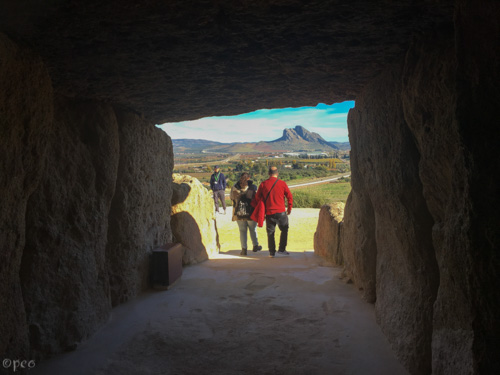
The tomb is orientated to the northeast, north of the sunrise on the summer solstice, and is the only known tomb so oriented in Europe in this cultural context. The Abrigo (shelter) of Matacabras, located at the foot of the northwest face of the Peña de los Enamorados, is closely linked with the Dolmen of Menga whose central axis points directly to it. In 2016, the dolmens of Menga, Viera, and El Romeral were all inscribed as a UNESCO World Heritage Site under the name "Antequera Dolmens Site". The dolmen sits 70 metres (230 ft) from the Dolmen de Viera and about 4 kilometres (2.5 mi) from another subterranean structure known as Tholos de El Romeral.

When the grave was opened and examined in the 19th century, archaeologists found the skeletons of several hundred people inside.
Dolmen of menga professional#
It is suitable for both those who wish to deepen their knowledge of this professional specialisation and those who seek the pleasure of a satisfied interest.After completion of the chamber (which probably served as a grave for the ruling families) and the path leading into the center, the stone structure was covered with soil and built up into the hill that can be seen today. This book combines the contributions of various university professors, who bring us up to date with their research, with excellent photographic illustrations and, for the first time, reflects the spread of this cultural phenomenon throughout Andalusia. In Andalusia, megalithic sites and landscapes express themselves with great richness and diversity, representing an exceptional source of scientific information for our understanding of our forebears’ ways of life, as well as a unique and beautiful historical legacy. On time, it acquired such a social and ideological depth that it became one of the most geographically and temporally widespread cultural phenomena ever known in Europe. The practice of monumentalising places of special significance by erecting large stones started during the Neolithic period, approximately 10.000 years ago. The megalithic phenomenon is one of the most exciting subjects of study in prehistory.


Together, these three examples suggest that the current focus on typology, chronology and contents in the study of Iberian megaliths needs to be matched with efforts to identify and interpret the often highly complex structure of the prehistoric landscapes of which they form an integral part. Lastly we describe a far more specific relationship which we have encountered in the Antequera region, where we believe we have identified a relationship between the orientation of the megalithic structure of Menga, a prominent natural feature and several newly discovered prehistoric sites.

In the second case (Aroche) we show correlations between the locations of megaliths and theoretical territories defined by isochrones and contrast this pattern with the distribution of non-megalithic funerary sites of the Early Bronze Age, concluding that the spatial distribution of megaliths in this region may relate to their role as landmarks. In the first (Almadén de la Plata) we find patterns of association between medieval transhumance routes and megaliths, and we use cost-surface modelling to suggest that medieval routes may reflect earlier, prehistoric patterns of movement which in turn suggest that megalithic structures functioned in this area as waypoints within an emerging mobility system for people and livestock. We discuss three case-studies for which fresh field data have been recently made available. Using examples from our work in southern Iberia, we employ GIS-based spatial analysis to explore for the first time various aspects of the landscape dimension of these monuments. Just as in other areas of Europe, however, southern Iberian megalithic structures must have played complex roles in the social organization of landscapes that go far beyond their use as funerary containers. Although the megalithic phenomenon in southern Iberia has received attention since the mid-nineteenth century, there has been very little attention paid to the role that megalithic structures played in the organization of prehistoric landscapes.


 0 kommentar(er)
0 kommentar(er)
